Along the banks of the Platte River, in the sandhills near Kearney, Nebraska, there is a staging area for a sandhill crane migration pattern that has been taking place since the beginning of time.

The Sandhill Crane, a bird for which fossil evidence dates back over nine million years, gathers along the Platte after wintering in the southern United States. Here it will graze on corn and alfalfa fields, and engage in an elaborate mating dance before heading north to Canada, Alaska and even Siberia to reproduce.
Pete and I headed down to Kearney, Nebraska, about 150 west of Omaha, to have a look. Kearney is the home of the annual Crane Festival every March, and it’s on the Bucket List of many a “bird nerd.”
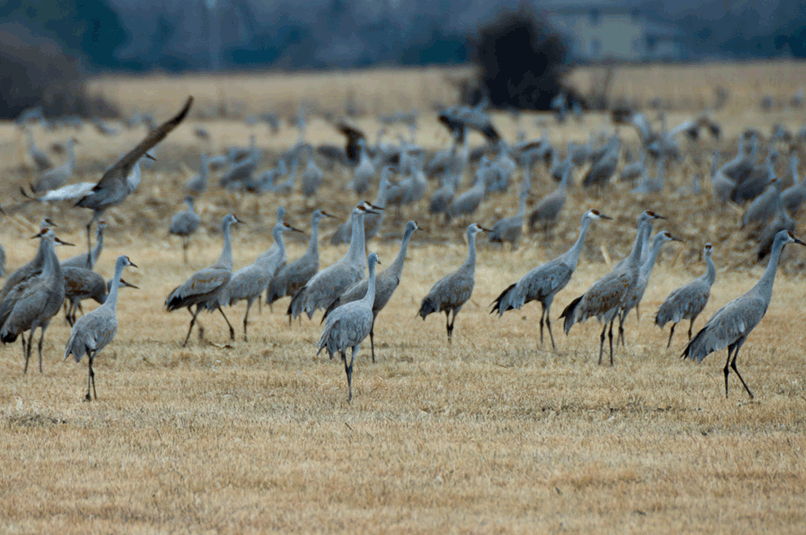
Photo by Pete Wuebker
A Sandhill Crane will range anywhere from about 3 to 4 feet high, and has a 6 to 7 foot wingspan. Long-legged with a slender neck, the Sandhill Crane has a flight profile which is completely extended (as opposed to that of a heron).
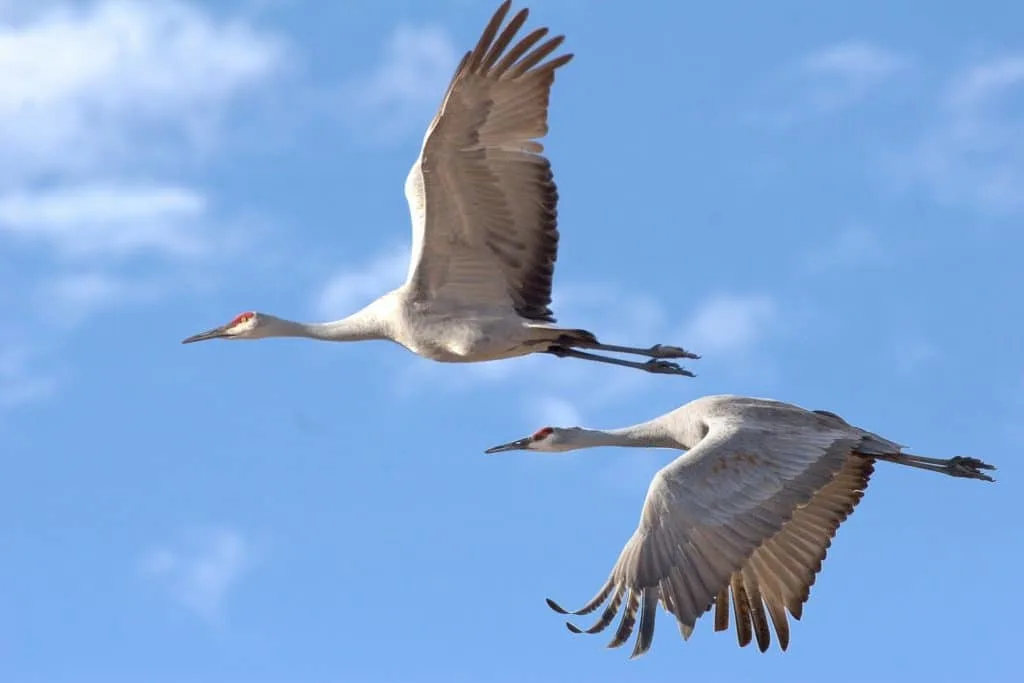
Each March, about half a million individual sandhill cranes descend along the banks of the Platte for this important stopover. Congregating in large groups, each morning they will awaken and fly off to the adjacent fields to forage, and then return again to the river at dusk.
This post contains affiliate links and/or references to our advertisers. We may receive compensation when you click on or make a purchase using these links.
A Sandhill Crane will often bond with its partner for life, and each couple will raise one “colt,” which will accompany its parents on the reverse migration south in the fall, and often again in the spring.
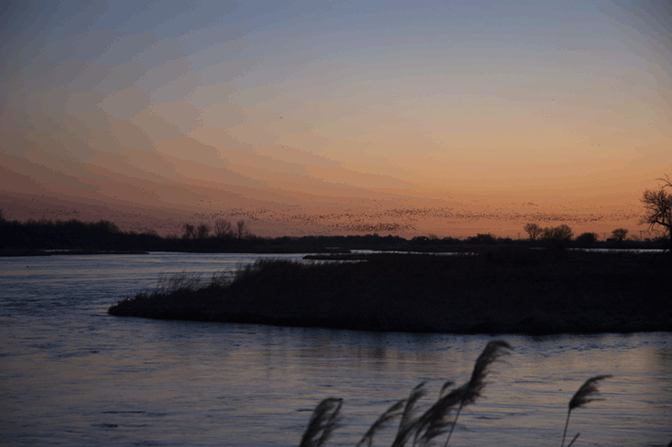
Photo by Pete Wuebker
The Sandhill Crane has a distinctive, trumpet-like call that carries for miles. When these hundreds of thousands of birds begin their day, their music is impressive.
The sheer numbers of birds are a breathtaking sight as the sun begins to rise, with groups of individuals gracefully forming and re-forming into beautiful flight patterns across the sky.
Soon after the first hint of morning light, you can see the large flocks beginning to form in the pale dawn just above the trees lining the river.
At the Audubon Rowe Sanctuary, just east of Kearney, we learned more about the Sandhill Crane. With numerical estimates only available since the 1940’s, the Sandhill Crane has achieved remarkable population growth in the intervening 70 years.
This is attributable to the increase in corn production in the Platte Valley. Unharvested leftovers provide a source of food that prepares the birds for the remainder of their migration, as well as the harsh arctic conditions in their summer nesting areas.
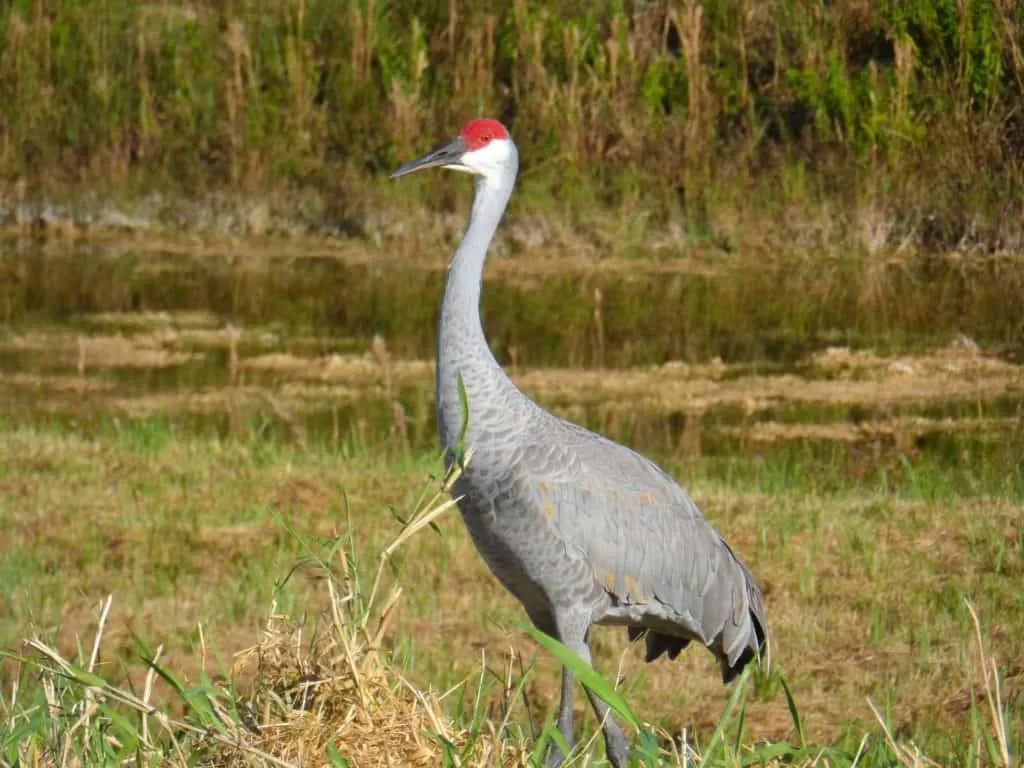
Paul A. Johnsgard, writing in the Prairie Fire monthly regional journal , believes that “as many as four generations of birds can be present in a single migrating assemblage. This factor, along with the great potential longevity of cranes, often exceeding 30 years in unhunted populations, allows for real cultural transformation of information from generation to generation. The older birds may actively or passively pass on important information about migration routes and migratory staging areas, as well as suitable and secure breeding and wintering sites.”
Each year, the Sandhill Crane twice navigates its 3,000 mile route. Johnsgard, who also authored Cranes of the World (available for download here), described as “the only serious world monograph on cranes,” says, “it is likely that an adult arctic-breeding Sandhill Crane knows more about the intimate geography of North America than does a professional airline pilot.”
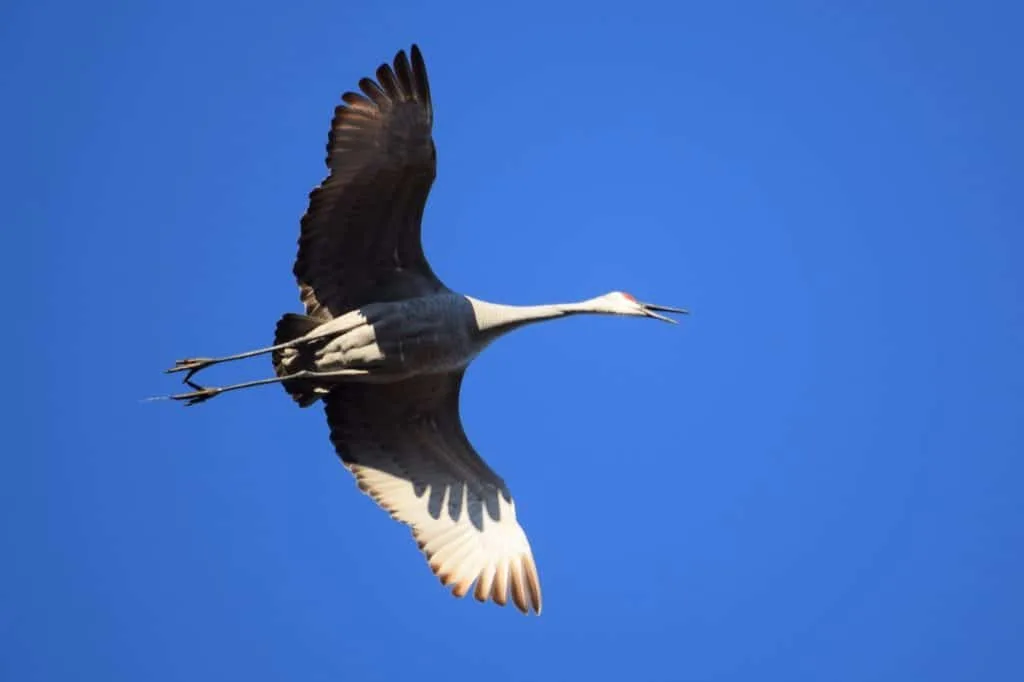
Native Americans noted and honored cranes in a variety of ways. Place names in Florida (Wauchula, in Hardee County, is one example), were given by the Seminoles as a description of the bird itself or its call.
The Pueblo people in New Mexico believed birds possessed universal “spiritual essences,” and associated the Sandhill Crane with certain clans.
The midwestern Miami Indians called themselves the Twightwee, which is supposedly an onomatopoeic reference to the Sandhill Crane, their sacred bird.
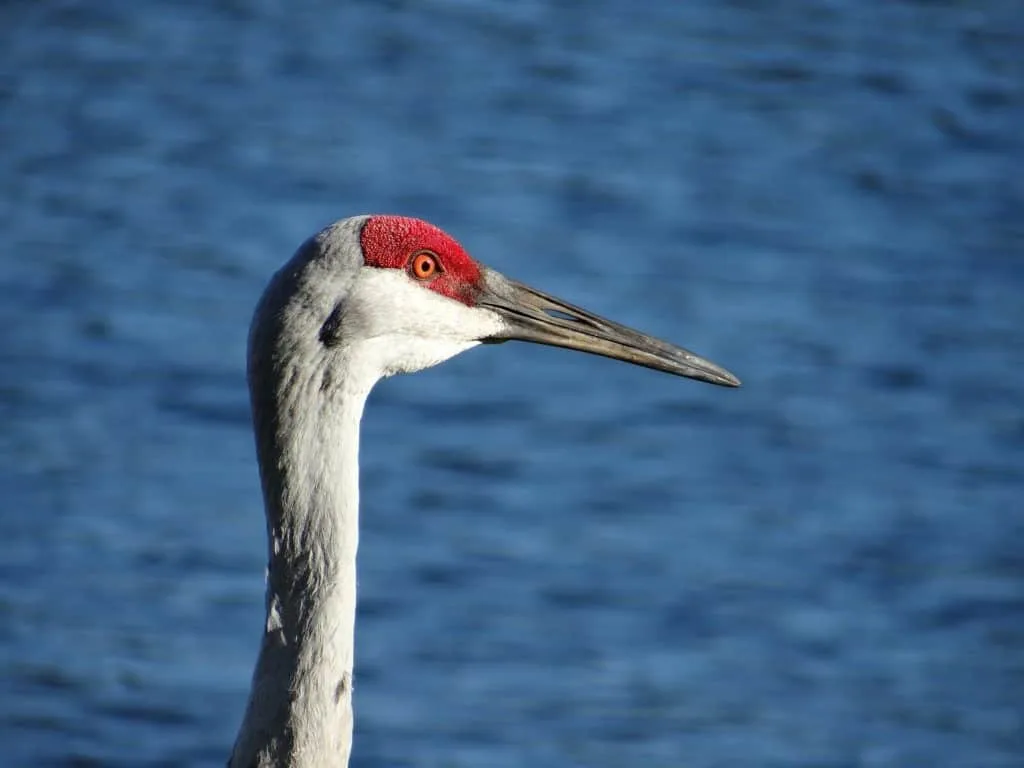
Asian cultures regard cranes as highly symbolic, and perform imitative dances. Wikipedia tells us that one such dance among the Ainu people was captured by photograph in 1908, and another has been performed in a Korean temple courtyard since the 7th century.
The ancient Greeks and Romans believed the crane was a bird of omen, and a moral sentry. Johnsgard cites the variety of legends, myths and folktales arising out of the crane’s “stature, intelligence, wariness and sociality” worldwide.
Cranes appear in such diverse mythology as the Iliad of Homer and the Trojan War hero, Palamedes, who was inspired to invent several Greek letters from observing the patterns of flying cranes.

The Rowe Sanctuary seems cheekily and aptly located in mid-America’s “flyover land”, which is intended to be a derogatory designation coined by the supposedly superior folks on either American coast. We’ll just let them continue to think that way.
Each year, Rowe celebrates the annual return of the Sandhill Crane with a series of educational workshops and programs. You can even rent a camouflage blind, giving you a front row seat from which to observe the spectacular show.
We decided we would set up our own viewing station on a riverside platform adjacent to a bridge just east of the Rowe Sanctuary. Arriving just prior to sunrise, we were joined by another “bird nerd,” a solitary traveler from the Detroit area. As the full moon set in the west over the river, the morning sky in the east grew pink, and the birds began to sound.
After a few more minutes, we stood transfixed as flock after flock, group after group, of Sandhill Cranes made their way out of the sanctuary grounds and into the air.
Their calls became a magnificent, joyful chorus, enveloping us in an experience shared by visitors to the Rowe Sanctuary from every state in the U.S., as well as 56 countries around the world, last year.
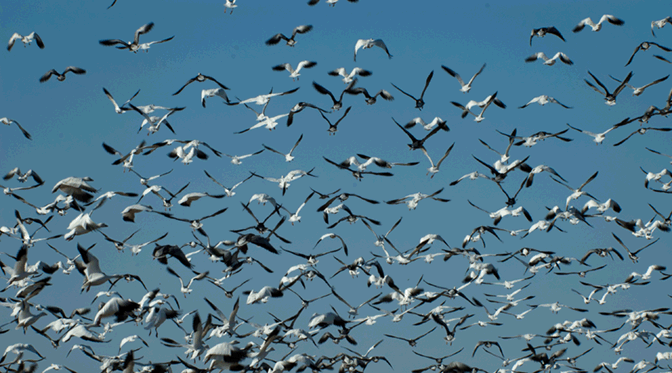
Photo by Pete Wuebker
With the sun higher in the sky, we grabbed a bite of breakfast in a hometown restaurant in tiny Gibbon, Nebraska, entertaining ourselves by eavesdropping on the good old boys’ conversation at the next table.
On the way back to Kearney, we were unprepared for some exceptional luck. Not only did we spot hundreds, if not thousands of Sandhill Crane groups in the fields lining the freeway.
A huge number of Snow Geese put on a spectacular show for us as they gathered along a tributary of the Platte. This unexpected treat capped off the morning.
If you’re interested in seeing this remarkable annual sandhill cranes migration, you may want to consider heading to Kearney in the middle of the week during March if you can.
Things to Do in Kearney, Nebraska
Best Places to Stay in Kearney, Nebraska
We enjoyed an uncrowded hotel, friendly mid-week service at the various restaurants and other venues, and most importantly, exceptional vantage points for optimum viewing that we suspect would not be duplicated with weekend festival crowds.
If you’re flying into Nebraska, you’ll want to rent a car in Omaha and head west on I-80 to Kearney, which is about 50 miles west of Grand Island. The Rowe Sanctuary is easily accessed from Exit 285 just east of Kearney at Gibbon.
Tips for Trip Success
Book Your Flight
Find an inexpensive flight by using Kayak, a favorite of ours because it regularly returns less expensive flight options from a variety of airlines.
Book Your Hotel or Special Accommodation
We are big fans of Booking.com. We like their review system and photos. If we want to see more reviews and additional booking options, we go to Expedia.
You Need Travel Insurance!
Good travel insurance means having total peace of mind. Travel insurance protects you when your medical insurance often will not and better than what you get from your credit card. It will provide comprehensive coverage should you need medical treatment or return to the United States, compensation for trip interruption, baggage loss, and other situations.Find the Perfect Insurance Plan for Your Trip
PassingThru is a participant in the Amazon Services LLC Associates Program. As an Amazon Associate I earn from qualifying purchases.
To view PassingThru’s privacy policy, click here.

Progress Report: Q1 2012 - Passing Thru
Thursday 8th of October 2015
[…] then spent a week in Michigan with family in February, and then several days in Nebraska for the Sandhill Crane migration. Utilizing methods you can learn from our Travel Resources list, we kept costs down quite well. […]
betsywuebker (@betsywuebker)
Monday 11th of March 2013
A year ago, we visited central Nebraska to witness an age-old phenomenon: the annual Sandhill Crane migration.... http://t.co/5gPVLc7boe
Davina Haisell
Wednesday 14th of March 2012
Fascinating footage, Betsy. Especially that last video.
I learned something new from reading your post: I did not know that their offspring were known as colts. Love the term "bird nerd." :) I'm interested in birdwatching myself and was gifted with a set of binoculars for Christmas. Now all I need to do is learn the names of the species that I see.
Betsy Wuebker
Friday 16th of March 2012
Hi Davina - Yes, the "colt" term was a new one on me, too. I would imagine that you have plenty of quality observation time on the island. The Sibley Guide is a good one to learn from, but I had best luck with little guides from Stan Takiela like Birds of Minnesota Field Guide, Second Edition, which are organized by color - bird identification for dummies :) He doesn't have anything for British Columbia, but I did find this little gem that you might find easy to use: Compact Guide to British Columbia Birds
EcoTourism comes to Nebraska. « EcoAdventureTravel Blog
Tuesday 13th of March 2012
[...] Sandhill Crane and Snow Geese Migration: Half a Million Strong (fc9b5.bigscoots-temp.com) Like this:LikeBe the first to like this post. Explore posts in the same categories: Eco-Tourism, educational, Environmentally Friendly [...]
Hilary
Sunday 11th of March 2012
Hi Betsy .. that must have been amazing .. birds have so much to offer, and are much 'cleverer' than we think .. there's so much to learn about them and from them ... Loved reading this - thanks - cheers Hilary
Betsy Wuebker
Tuesday 13th of March 2012
Hi Hilary - So glad you enjoyed this. It is the experience of a lifetime. :)